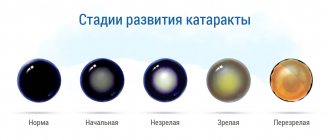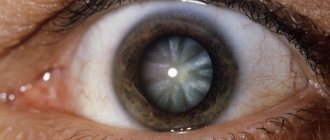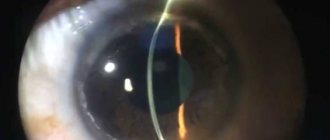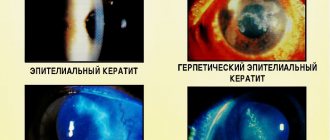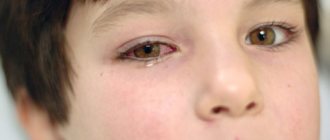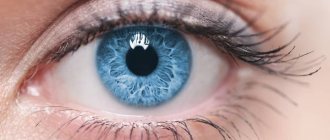Complicated cataract is a clouding of the lens that develops under the influence of some unfavorable circumstances. The most common causes are endocrine changes, diabetes mellitus, long-term impaired water metabolism, diseases of the central nervous system and infectious, dermatological pathologies of various origins, physical exhaustion, etc. In addition, complicated eye cataracts can be caused by traumatic damage to the tissues of this organ and pre-existing ophthalmological a disease left without treatment, such as glaucoma or iridocyclitis.
Complicated cataract - features and differences
Cataract is an eye disease that most often makes itself felt in old age. The protein base of the lens undergoes specific changes with the development of pathology. As a result, the main optical lens loses its inherent transparency and becomes cloudy, which entails a decrease in visual acuity. The disease disrupts a person’s usual way of life. To restore lost capabilities, the patient consults an ophthalmologist.
Complicated cataract is a severe form of disorder that develops against the background of concomitant diseases. Chronic pathologies complicate the course of cataracts, which requires professional help from specialists. Usually the disease develops in one eye, although in medical practice there are cases of the formation of bilateral type disorders (in two eyes).
Pathology develops in young people and elderly patients. Women suffer from this disease more often than men. Lens clouding is irreversible, the pathology progresses, which can lead to complete blindness in a short period of time. A timely visit to the clinic is the only chance to save your vision.
Prevention
The likelihood of developing the disease can be reduced by maintaining a healthy lifestyle by quitting smoking and alcohol, as well as protecting the organ of vision from injuries and adverse environmental factors.
It is recommended to treat diseases of the eyes and internal organs in a timely manner to avoid secondary changes in the structures of the eye. Visit your ophthalmologist regularly, at least once a year. This will help identify the disease at an early stage and prevent the development of an immature form of pathology.
Share your opinion about immature cataracts in the comments, repost on social networks. Take care of your health, all the best.
Classification and causes of the disease
Doctors distinguish complicated cataracts associated with general diseases of the body. In this case, the cause of the disease becomes:
- Hormonal imbalances, disruptions in the endocrine system.
- Disharmonious metabolic processes, vitamin deficiency, intoxication.
- Diabetes mellitus (in this case, complicated cataracts develop quickly and easily affect both eyes). The combination of these diseases occurs in 40% of cases. A clear sign of this type is vision that changes throughout the day.
- Convulsions, failure of water-salt metabolism. Lead to the tetanic form of the disease.
- Neuromuscular lesions of a hereditary nature. They provoke the development of myotonic complicated cataracts, which are characterized by numerous areas of turbidity and shiny particles (cholesterol crystals).
- Dermatological problems (eczema, neurodermatic plaques, scleroderma) and other causes.
Concomitant eye diseases
- Inflammation of the choroid and retina (chorioretinitis). Develops with weakened immunity, against the background of bacterial or viral infections.
- Iridocyclitis. The inflammatory process affects the ciliary body, the iris of the eyeball.
- Dystrophic changes in the iris.
- Glaucoma with increasing intraocular pressure.
- Injuries and damage, cancerous tumors.
Congenital eye anomalies play a great role in the development of the disease. During the examination, the ophthalmologist asks questions to determine your medical history and learns about taking medications. This is due to the fact that certain groups of pharmacological agents can also provoke a complicated form of cataract (corticosteroids, glaucoma drops).
Causes of cataracts
What causes cataracts? For different reasons.
- The most common is the so-called senile (age-related) cataract. This type of cataract usually occurs in people over fifty years of age. The cause of its appearance is associated with chemical changes in the lens of the eye.
- Complicated cataracts are formed as a result of pathological processes occurring in the eye (for example, inflammation of the choroid, glaucoma) or diseases such as diabetes, kidney failure, skin diseases, etc.
- Traumatic cataract of the lens is usually caused by mechanical damage, as a result of which intraocular fluid penetrates into the lens capsule.
- Toxic cataracts occur due to the harmful effects of certain medications and chemicals.
Risk factors for developing lens cataracts also include:
- The presence of cataracts in close relatives;
- Prolonged exposure to ionizing or infrared radiation;
- Excessive insolation (prolonged exposure to the sun without sunglasses);
- Smoking;
- Hormonal changes.
Photo: Shutterstock.com
Types and stages of complicated cataracts
In medicine, it is customary to distinguish the stages of cataracts, each of which has its own clearly defined features:
- Initial stage - changes are not yet clearly expressed. Upon examination, infiltration becomes noticeable, affecting the internal structures of the eye.
- Immature form - at this stage the patient usually consults a doctor due to deterioration of vision. During an ophthalmological examination, the features of a developing cataract become noticeable.
- Mature form - at this stage there is a change in the transparency of the eye structures. The area with infiltration is a light-colored spot in the area of the pupil and iris. The defect is visible from the outside and causes discomfort to the patient.
- Overripe cataracts cause blindness.
The clinical picture of the disease is also different. In the swelling form, the turbidity is insignificant; the pathology does not manifest itself for a long time. With posterior capsular symptoms, symptoms quickly worsen. And incomplete complicated cataract is expressed in a large number of areas of opacification that impair the functions of the eye.
It should also be said that complicated cataracts may have a secondary development. It can appear after surgery to replace the lens.
Cataracts and presbyopia
Cataracts (senile) and age-related farsightedness (presbyopia) are eye diseases that are typical for people over forty years of age. Both diseases are associated with the functioning of the lens.
Presbyopia is an age-related progressive decrease in vision, the development of so-called age-related farsightedness, when with age it becomes increasingly difficult to see clearly near, for example, to read. This is mainly due to a decrease in the elasticity of the substance and capsule of the lens, a change in its thickness and shape.
Cataract is clouding of the lens. Its transparency is impaired, which means it stops transmitting a sufficient and complete amount of light rays, and the picture ceases to be clear. The difference between the diseases is also that presbyopia can be corrected with near glasses and contact lenses, while cataracts cannot.
Symptoms
The vast majority of cases of this disease have a posterior capsular form. This is facilitated by the lack of normal epithelial protection of the lens, which makes its contact with toxins pronounced. Symptoms of violations:
- Increasing pressure in the eyes.
- The color of complicated cataracts (ivory), which is associated with a large number of infiltrates.
- The patient begins to see worse; when looking at a light source, halos appear before the eyes.
- The ability to adapt vision to night time mode decreases, dark spots appear before the eyes more often, and “spots” flash.
Incomplete cataracts are also characterized by disturbances in the perception of background colors, unclear vision of the contours of objects, and contrasting combinations.
What is the “maturation” of cataracts?
Cataract is the process of clouding of the lens, which is located inside the eyeball. This part of the eye is responsible for focusing and refracting light. The disease can have a different nature and occur at different ages, but the vast majority of patients with cataracts are elderly people over 60 years of age. The cause of senile cataracts is a natural change in the structure and transparency of the eye lens, which with age loses its elasticity and becomes much denser.
The age-related form of the disease usually develops gradually over 5-15 years. The pathological process is irreversible, and every year the cloudiness becomes more pronounced. The development of cataracts from the initial stage, when vision is still preserved, to the last, most severe stage, when the patient practically no longer sees, is called “maturation”. Accordingly, the stages of development of the disease are divided into initial, immature, mature and overripe cataracts? What is the difference?
Diagnosis of the disease
Diagnostic screening begins with a visit to an ophthalmologist. The doctor examines the eyes, listens to the patient’s complaints, and finds out his medical history. If a pathology is suspected, an in-depth examination is required using instrumental diagnostic methods:
- Biomicroscopy is a non-contact study of the internal structures of the eyeball. The doctor uses a slit lamp, with which he directs the light stream to examine the anatomical data of the eye in detail. Using a microscope, the ophthalmologist obtains complete information about the cornea, lens, and anterior segment.
- Refractometry is a computer analysis of the eyes that has a high diagnostic value. In Dr. Trubilin’s clinic, the examination is carried out using an automatic refractor, which allows the refractive power, radius features of the cornea and the refraction of the patient’s eyes to be determined with maximum accuracy.
As part of the diagnosis, an examination of the fundus of the eye is performed, peripheral vision is assessed, and the pressure inside the eye is measured. If necessary, the patient is referred to specialized specialists who monitor the course of concomitant diseases.
Treatment of complicated cataracts
Conservative methods are rarely used in the first stages of the disease due to their low effectiveness. To improve blood circulation in the tissues and provide nutrition to the affected structures of the eyeball, topical drops and systemic medications are used.
The following techniques are used in the treatment of complicated forms of cataracts:
- Intracapsular extraction - the lens is removed along with the capsule. Recommended for weakening of the ligaments of Zinn accompanying subluxation of the natural lens. After extracting the natural components of the eyeball, the doctor implants an anterior chamber lens IOL inside.
- Phacoemulsification of cataracts - a specialist destroys the lens with directed ultrasound. The patient does not feel pain. The operation is fast. Active flow phacoemulsification is the most common method in ophthalmological practice.
- Phacoemulsification of cataracts with femtosecond assistance. The optimal method for removing complicated cataracts. During the session, the doctor uses a femtosecond laser, which destroys the structure of the lens. The intervention is considered safe, the surgeon’s actions are gentle.
Once the doctor removes the lens, an intraocular lens is implanted. An artificial IOL is placed in place of the natural element. The overall outcome of the operation depends on the patient’s health status, the presence of concomitant chronic diseases, timely visit to the clinic and compliance with all doctor’s recommendations.
Dr. Trubilin's clinic uses the latest methods for diagnosing and treating eye diseases . Sign up for a consultation at the first signs of illness to promptly eliminate bothersome symptoms. Don't forget about the need for scheduled visits to your doctor. Thanks to them, it is possible to detect early changes in the structure of the visual organ in a timely manner. Timely treatment contributes to eye health and well-being for our patients.
How does lens cataract affect vision?
Cataracts affect the lens of the eye. The lens is one of the main refractive structures of the eye, focusing light rays on the retina. It is an elastic body shaped like a biconvex transparent lens. Essentially, the lens captures light as it passes through the pupil and focuses it onto the retina. Around the lens, the choroid forms the ciliary body, which contains a muscle that regulates the curvature of the lens, which ensures clear and distinct vision of objects at different distances.
The lens in the eye is “suspended” on thin radial threads that encircle it with a circular belt. The outer ends of the threads are attached to the ciliary muscle. When this muscle is relaxed (in the case of focusing the gaze on a distant object), the ring formed by its body has a large diameter, the threads holding the lens are tense, and its curvature, and therefore the refractive power, is minimal. When the ciliary muscle tenses (when viewing a nearby object), its ring narrows, the filaments relax, and the lens becomes more convex and, therefore, more refractive. This property of the lens to change its refractive power, and with it the focal point of the entire eye, is called accommodation.
Thus, we understand that the lens performs a very important function, and disturbances in its functioning directly affect vision.
Changes in the structures of the lens lead to diseases such as cataracts and presbyopia.
Photo: Shutterstock.com
